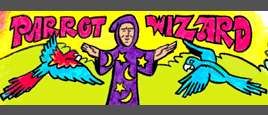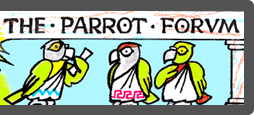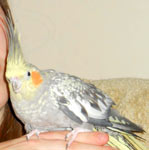


What to do next?
8 posts • Page 1 of 1
What to do next?
Finally, a large milestone between me and Koki(I renamed him)! He now steps up willingly, and everytime I go near the cage, he goes to the center of his perch, which is where I feed him treats. Now that he will step up willingly, I do not exactly know how to progress without losing the bond that we now have. He also seems clumsy, since he will lose his balance many times on perches and on my hand, and he is obviously not used to flying, since he was clipped since I bought him. He also had a feather problem; a few of his tail feathers were "suspicious-looking', but now they are starting to break off. I don't know if he's sick, or if he's just molting. In terms of training, I would like to know how to introduce him to getting scratched, and also how to get him used to being outside (I'm too scared to take him outside his cage right now because he might not go back in, and I might have to force him in). Sorry for the amount of questions asked, but I'm just so excited and don't know how to progress! 





- Tiellove
- Parrotlet
- Gender:

- Posts: 17
- Number of Birds Owned: 4
- Types of Birds Owned: Parakeets
Cockatiel - Flight: No
Re: What to do next?
How old is Koki again? The balance might not be an issue, as my tiel was also very uncoordinated when I first got him, but with time he learned to balance himself. Also, could you provide pictures of the breakage? You would know if the feathers were coming out naturally because they would come out looking like quills, with the tube end attached. The best guess I can give you is that he had stress bars and now his tail is breaking at that point? But I think pictures would lead to a more accurate conclusion.
- shiraartain
- Poicephalus
- Gender:

- Posts: 403
- Number of Birds Owned: 1
- Types of Birds Owned: Yellow-Sided Green Cheek Conure, Quaker, Ringneck
- Flight: Yes
Re: What to do next?
Harlie didn't fly at all when I first got her and was never let out the cage prior to me getting her so even though she has never been clipped she had a terrible sense of balance and her muscles were very weak. She started flying regularly almost 2 years ago I think and as her flight gets stronger and her muscles improve, her sense of balance seems to be improving with it. She still sometimes loses her balance if she gets really excited but she saves herself a lot better now.
That said there are plenty of other reasons why your bird might be losing balance and be generally uncoordinated -bad diet, neurological problems are a couple of examples. I would be popping off to an avian vet to get checked out just in case.
What I will say is that feathers shouldn't just break off, occasionally they might damage the odd one- especially if the birds prone to night flights or the cage is incorrect for the bird. Have a look at the tips of the ones that have come off- do they look broken or does the shaft come to a perfect point? If its the latter then the birds probably just shedding. If they are breaking you need to look at the birds diet, cage and other husbandry issues as something's weakening them- again a vet can rule out certain diseases for you.
How long have you had Koki now and what feeding schedule is koki on? This can help us advise you regarding training.
That said there are plenty of other reasons why your bird might be losing balance and be generally uncoordinated -bad diet, neurological problems are a couple of examples. I would be popping off to an avian vet to get checked out just in case.
What I will say is that feathers shouldn't just break off, occasionally they might damage the odd one- especially if the birds prone to night flights or the cage is incorrect for the bird. Have a look at the tips of the ones that have come off- do they look broken or does the shaft come to a perfect point? If its the latter then the birds probably just shedding. If they are breaking you need to look at the birds diet, cage and other husbandry issues as something's weakening them- again a vet can rule out certain diseases for you.
How long have you had Koki now and what feeding schedule is koki on? This can help us advise you regarding training.
-

marie83 - Cockatoo
- Gender:

- Posts: 3565
- Location: Midlands, UK
- Number of Birds Owned: 2
- Types of Birds Owned: Yellow sided Green Cheek Conure
Pineapple Green Cheek Conure - Flight: Yes
Re: What to do next?
Yes, housing and diet need to be specified and, also, are we talking about a baby or an adult? Because that makes a big difference, too - basically because broken feathers and imbalance could be caused by a real bad diet even in a flighted adult.
- Pajarita
- Norwegian Blue
- Gender:

- Posts: 18705
- Location: NW Pa
- Number of Birds Owned: 30
- Types of Birds Owned: RoseBreasted too, CAG, DoubleYellowHead Amazon, BlueFront Amazon, YellowNape Amazon, Senegal, African Redbelly, Quaker, Sun Conure, Nanday, BlackCap Caique, WhiteBelly Caique, PeachFace lovebird, budgies,
- Flight: Yes
Re: What to do next?
[/img]car[/img]Well he has a 24x24x30in cage and I feed him a mix of pellets and seeds. Ive tried introducing veggies and fruits but he doesnt touch them. Hes about two and a half months old.
- Tiellove
- Parrotlet
- Gender:

- Posts: 17
- Number of Birds Owned: 4
- Types of Birds Owned: Parakeets
Cockatiel - Flight: No
Re: What to do next?
Baaad diet all high protein. An all seed diet has been proven to be bad for parrots, and pellets are nothing but ground up seeds plus any chemicals and other additives the feed company decides to throw in them. They were meant to replace seeds, not to be fed in addition to seeds.
If you wish to have a healthy bird you cannot afford to feed your bird in this manner. Feed your bird either seeds or pellets for dinner and then remove what it does not eat after it goes to sleep for the night. Give it a variety of fresh vegetables for breakfast and for all day nibbling. Also feed as part of its breakfast some cooked whole grains.
If you have bird proofed the room that the bird is in then just open the cage and let the bird come out on its own. You should not have to force the bird to do anything as it steps up when you ask it to. When it is time to put your bird in its cage simply ask it to step up and then give it a good treat when you put it in its cage.
When it comes to your bird you really need to eliminate the thought and/ or concept of forcing it from your mind period as it is totally counterproductive. If you have to force your bird to do anything then you have not taken the time to think things through and then put in the time to teach the bird what it is that you want from it.
If you wish to have a healthy bird you cannot afford to feed your bird in this manner. Feed your bird either seeds or pellets for dinner and then remove what it does not eat after it goes to sleep for the night. Give it a variety of fresh vegetables for breakfast and for all day nibbling. Also feed as part of its breakfast some cooked whole grains.
If you have bird proofed the room that the bird is in then just open the cage and let the bird come out on its own. You should not have to force the bird to do anything as it steps up when you ask it to. When it is time to put your bird in its cage simply ask it to step up and then give it a good treat when you put it in its cage.
When it comes to your bird you really need to eliminate the thought and/ or concept of forcing it from your mind period as it is totally counterproductive. If you have to force your bird to do anything then you have not taken the time to think things through and then put in the time to teach the bird what it is that you want from it.
- Wolf
- Macaw
- Gender:

- Posts: 8679
- Location: Lansing, NC
- Number of Birds Owned: 6
- Types of Birds Owned: Senegal
African Grey (CAG)
Yellow Naped Amazon
2Celestial Parrotlet
Budgie - Flight: Yes
Re: What to do next?
Here are a few things that might help. No need to force your bird back into his cage. Work with him on stepping up on a perch first and see if he will. This will help you to get him back in his cage if he won't step up on your finger. As for his tail feathers I have a green cheek conure that is the same way he is always breaking a tail feather. They do that by climbing around on their cage and sticking their tail feathers through the bars. 

It takes a great man to give advice tactfully
But a greater to accept it graciously
Logan Pearsall Smith
But a greater to accept it graciously
Logan Pearsall Smith
- Tman007
- Conure
- Gender:

- Posts: 227
- Location: Las Vegas Nv
- Number of Birds Owned: 2
- Types of Birds Owned: Galah (rose breasted cockatoo)
Cockatiel - Flight: Yes
8 posts • Page 1 of 1
Return to Taming & Basic Training
Who is online
Users browsing this forum: No registered users and 14 guests
